Introduction:
Hello my friends – I have a few hours to spare today which means it’s time for another switch review. I’ve been typing on the Ajazz × Huano Diced Fruit Kiwi switches daily for a couple weeks now, and while I have to say these aren’t for everyone, they’ve made a fan of me.
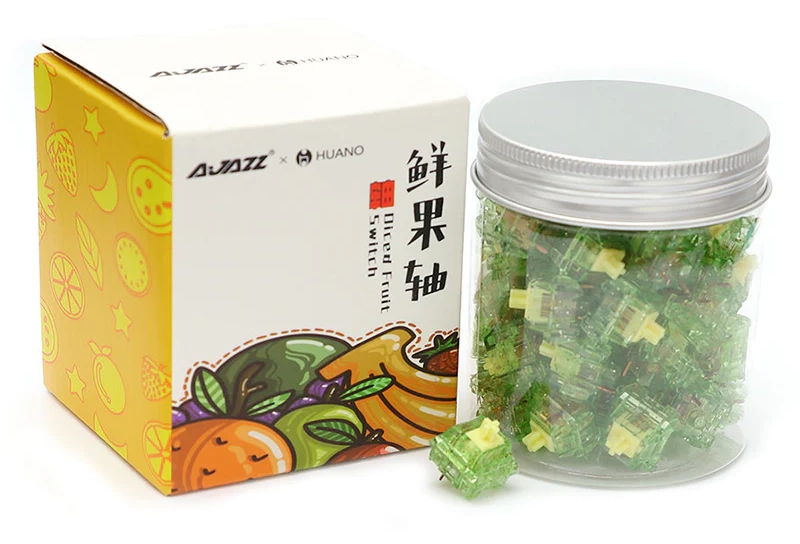
Product photo for the Diced Fruit Kiwis from the Ajazz website
For the sake of brevity, I’m going to call these “DF Kiwis” from here forward. Let’s get into it!
The Basics:
- Type: Tactile
- Sub-types: Top-bump • T-shaped bump • Long-pole
- Brand: Ajazz
- Manufacturer: Huano
- Housing: PC top • Nylon bottom
- Stem: Assuming POM • long-pole
- Actuation • Travel: 1.9mm • 3.3mm
- Spring weight: 60g • 50g • 60g*
- Spring type: 21mm • two-stage
- Factory lube: Yes • light grease
- Mounting: Plate • 3-pin
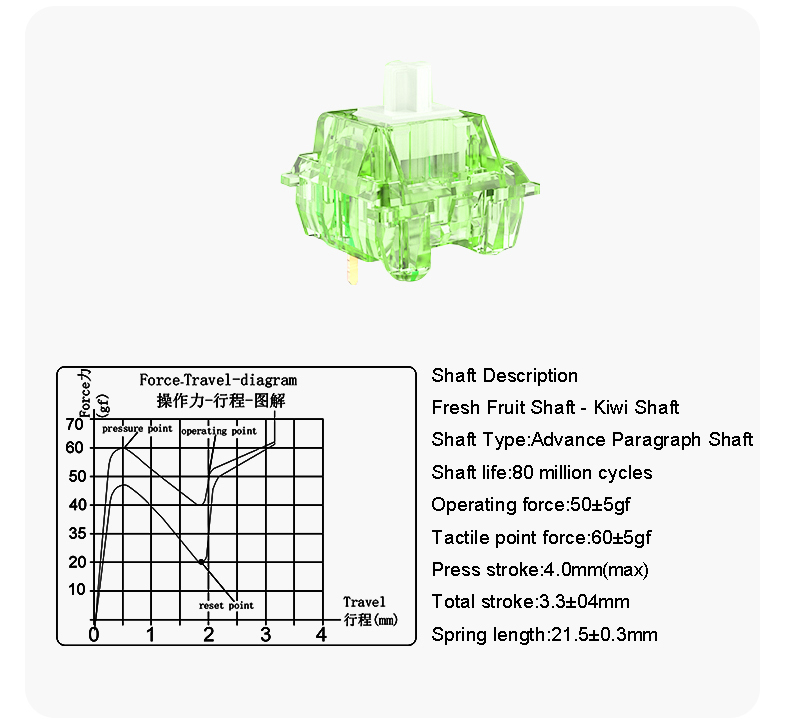
The illustrated force curve graph and switch render from the factory spec sheet
*If this weight distribution looks a little strange, that’s because it is. While the spring itself should theoretically let you start moving the stem at around 35-50g of pressure, the tactile bump at the top keeps it from moving until you’ve applied around 60g – which is nearly the same amount required to bottom-out the whole switch. Actuation happens between those two crests right after the lowest dip at around 50g.
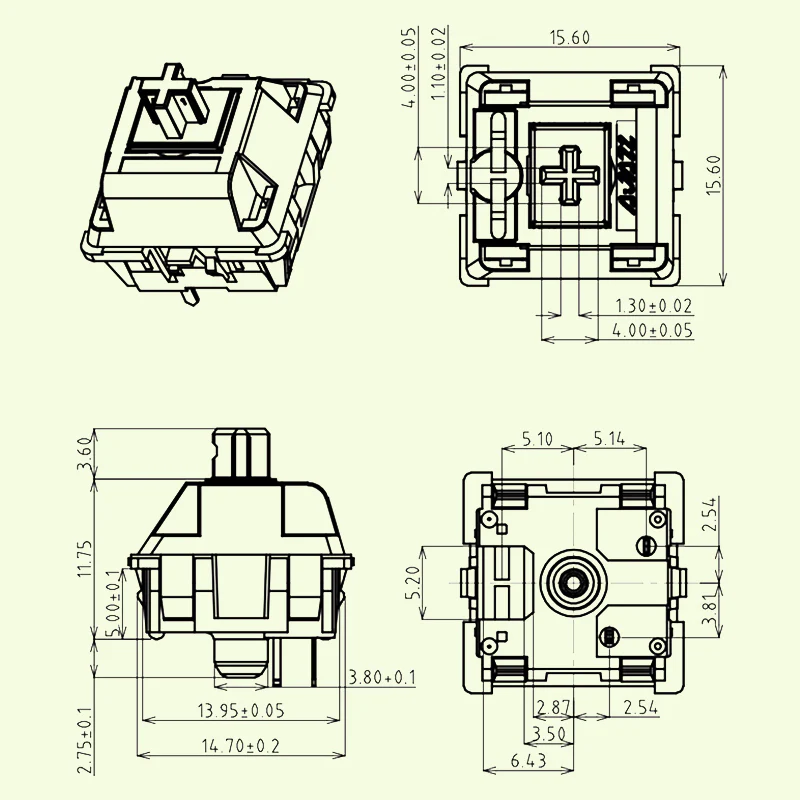
Spec sheet drawing of the Ajazz Diced Fruit Kiwi switch
Context & Background:
I honestly don’t have much to share here, aside from these being one of the first switches I saw that included glitter inside the housing plastic. The real elephant in the room here is the already successful Kiwi switch from The Key Company and C3 Equalz; more or less a boutique T1 variant. Whether or not that switch played-into the naming and/or character of this switch is the stuff of speculation – seems likely, but who knows.
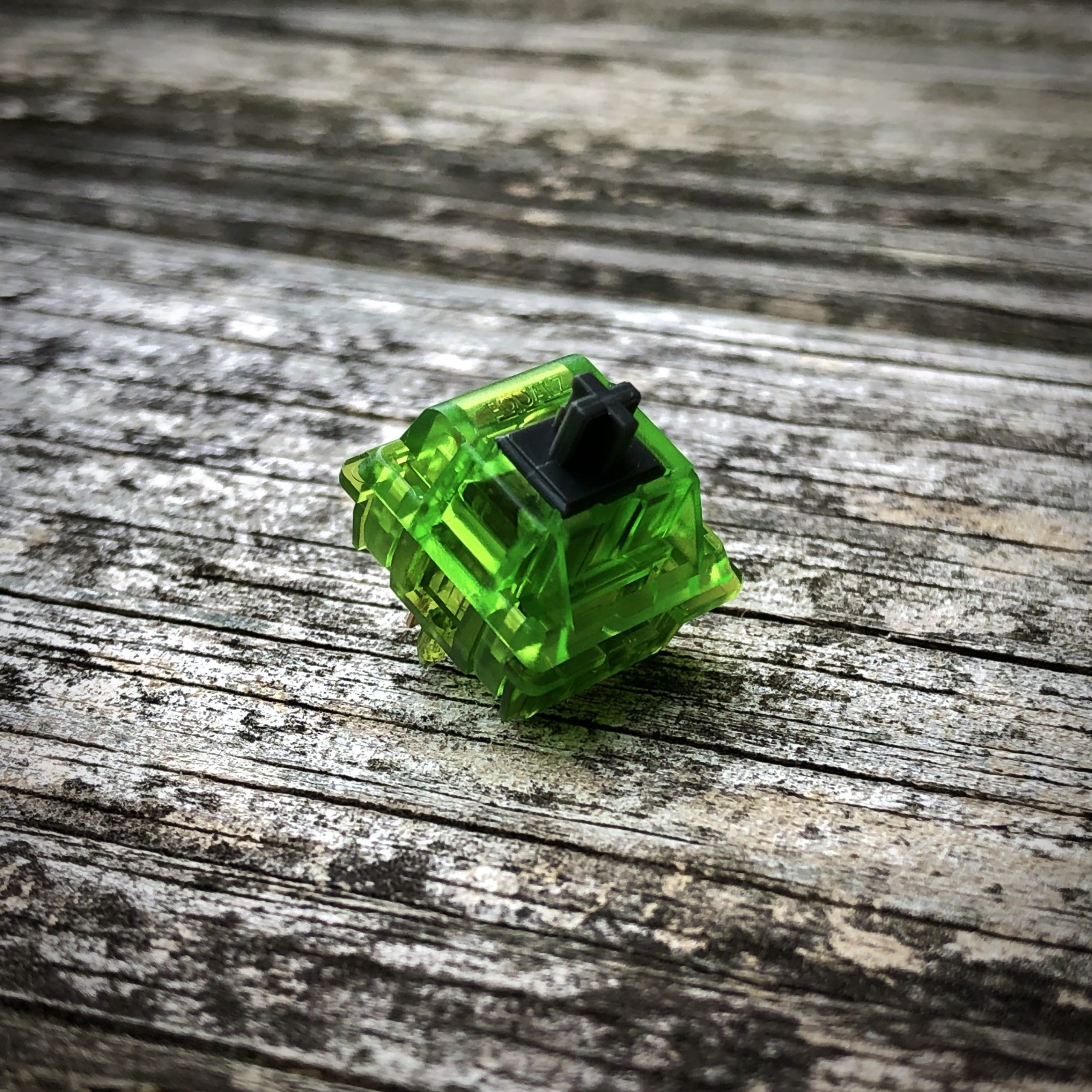
A TKC × C3 Equalz Kiwi, with its own custom housing and grey T1 stem borrowed from the Koala.
As of writing these have been around at least a couple years; I’m just now getting around to them myself thanks to a holiday gift card and a bit of curiosity. Like TKC, Ajazz is approaching a fruit-themed series here – specifically “diced” – don’t want any lawyers getting too excited.
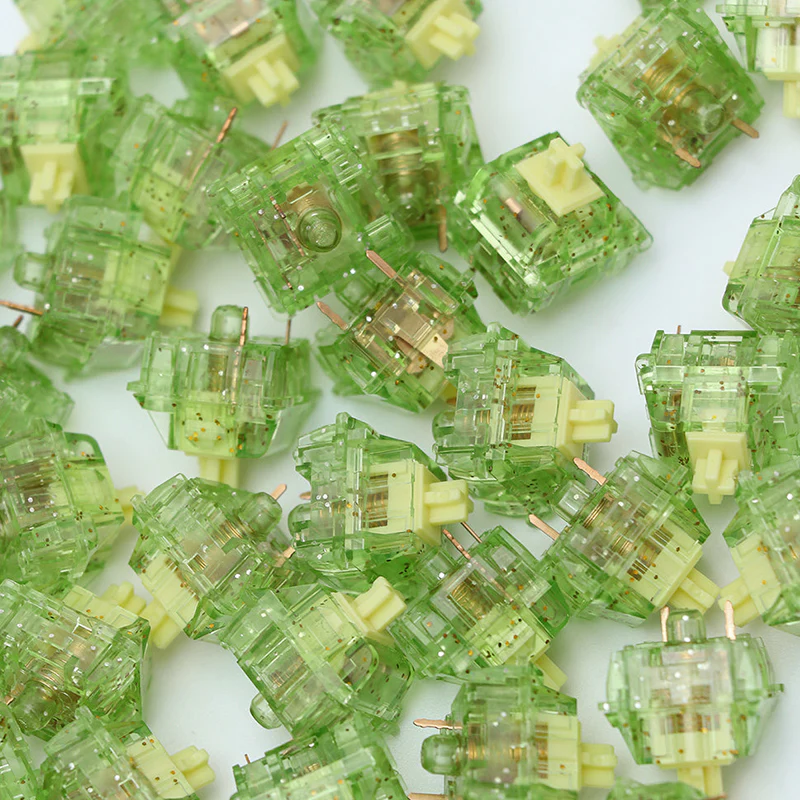
An official product photo for the DF Kiwis; a little similar, a lot distinct
I’d also like to briefly touch on a topic I’ll be covering more in-depth in the near future, because this switch is such an excellent example of it. For me, this switch is emblematic of why I don’t really encourage anyone other than switch nuts to engage in frankenswitching these days. That is, a few years ago, the only way to get a switch like this one would be to combine switch parts from different manufacturers that use different specs for things like how deep the central tube is, or how long the central stem pole is.
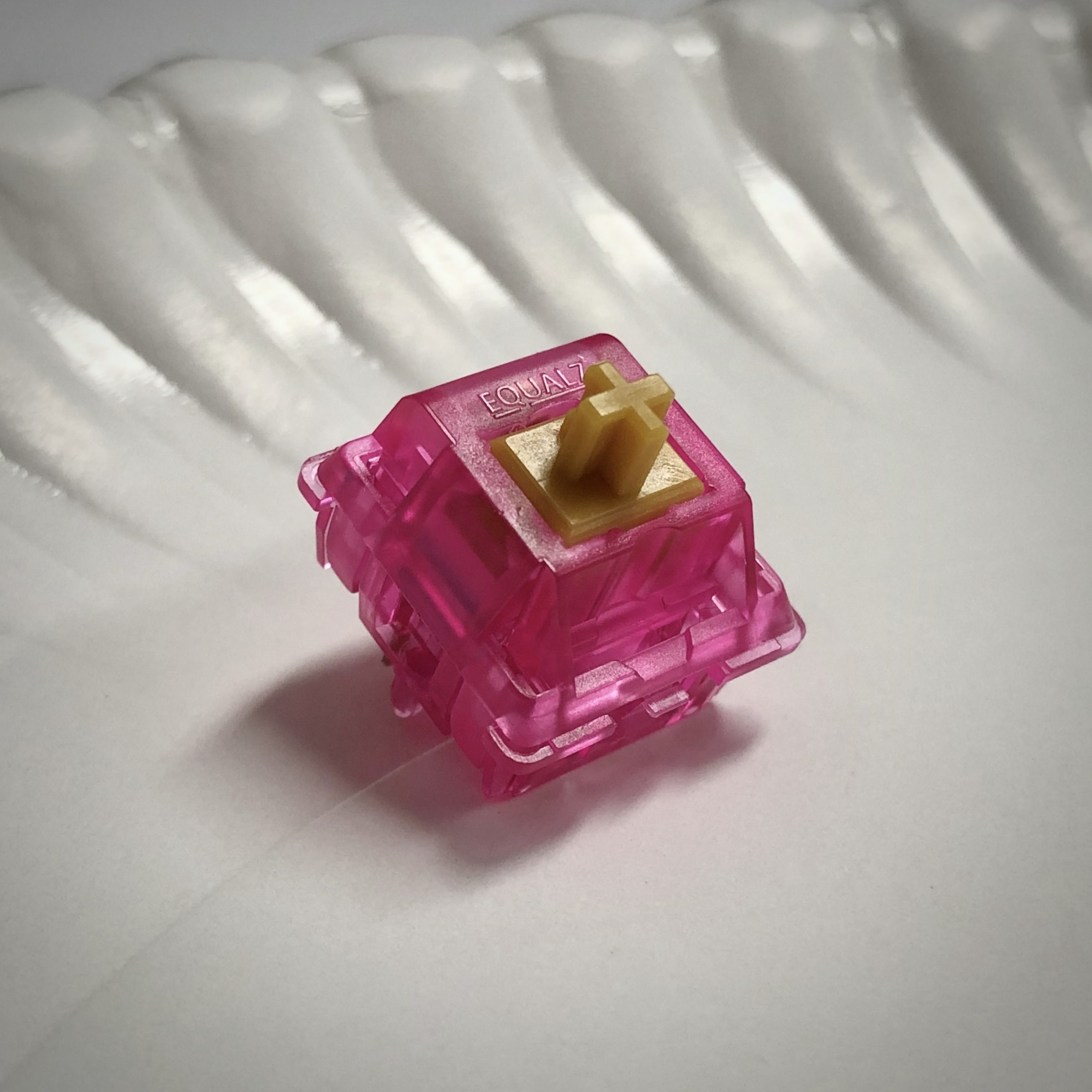
A favorite funky frankenswitch I think the DF Kiwi makes more or less redundant; a TKC Dragonfruit housing paired with a Gazzew U4T stem, which I nicknamed “PB&J”
Around that time, variety hadn’t quite exploded yet, and frankenswitching was a great way to explore new possibilities that weren’t available widely (or at all) in the commercial market. While it’s still a fun way to learn, many of my favorite franken-styles can be had for less money and effort as commercial switches these days; and the DF Kiwi is a perfect example.
When I saw people looking for a super-short, all-bump tactile, I’d recommend Halo or U4T stems in JWK housings with long springs. Now I recommend DF Kiwis.
Aesthetics:
One might think this is the most distinguishing feature of these switches, and that would be a reasonable assumption if not a correct one. Even today these are very distinctive in appearance, even more-so when they were first released. The colors here are more directly inspired by a slice (or dice) of kiwi than TKC’s version; lighter yellow-greens complete with little speckles to simulate the seeds. I love the look of the T1 Kiwi – so much so that I had a custom stained-glass window made in reference to it – but I have to hand it to Ajazz here, this look does a fantastic job as visual reference to actual kiwi fruit.

Actual kiwi fruit
Those speckles I mentioned are actually glitter flakes embedded in the housing plastic. There are a few switches with glittery housings these days, but I think most of those have more fine sparkly bits than the discernible flakes here. These mainly provide dark contrast to the light yellow-green plastic like seeds, but do occasionally scintillate as they reflect the light like the shiny, almost sparkly texture of sliced kiwi fruit. These switches are instantly recognizable and fun to look at, and I also think they nail the theming. That’s why I’m giving them a subjective A+ when it comes to aesthetics.
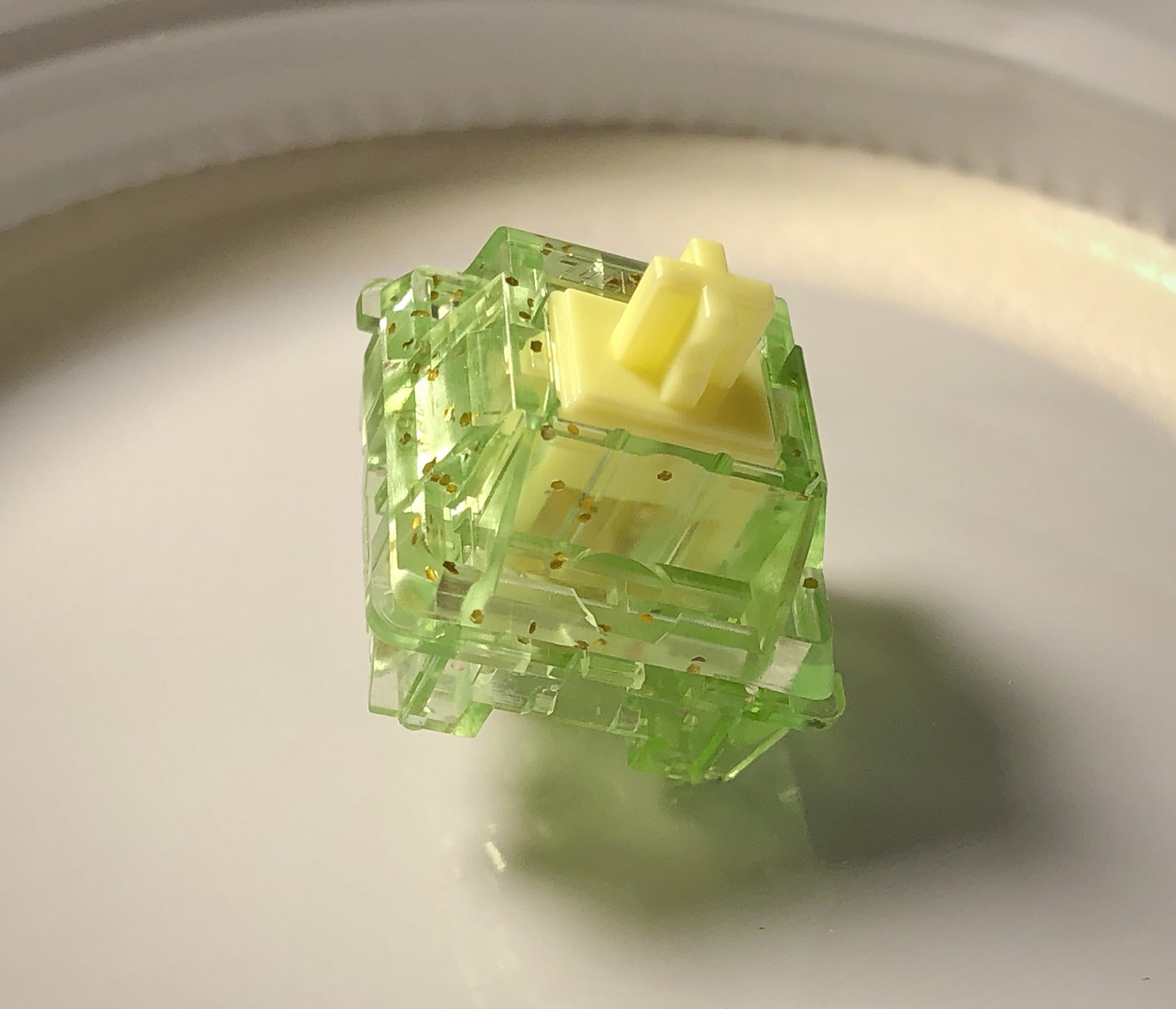
I think they nailed it
One other note here; I could discern at least two distinct styles of logo badge in the batch I have, mixed together in both packs. One has a badge with the same surface look as the surrounding plastic, one has a different surface there, generally making for more contrast.
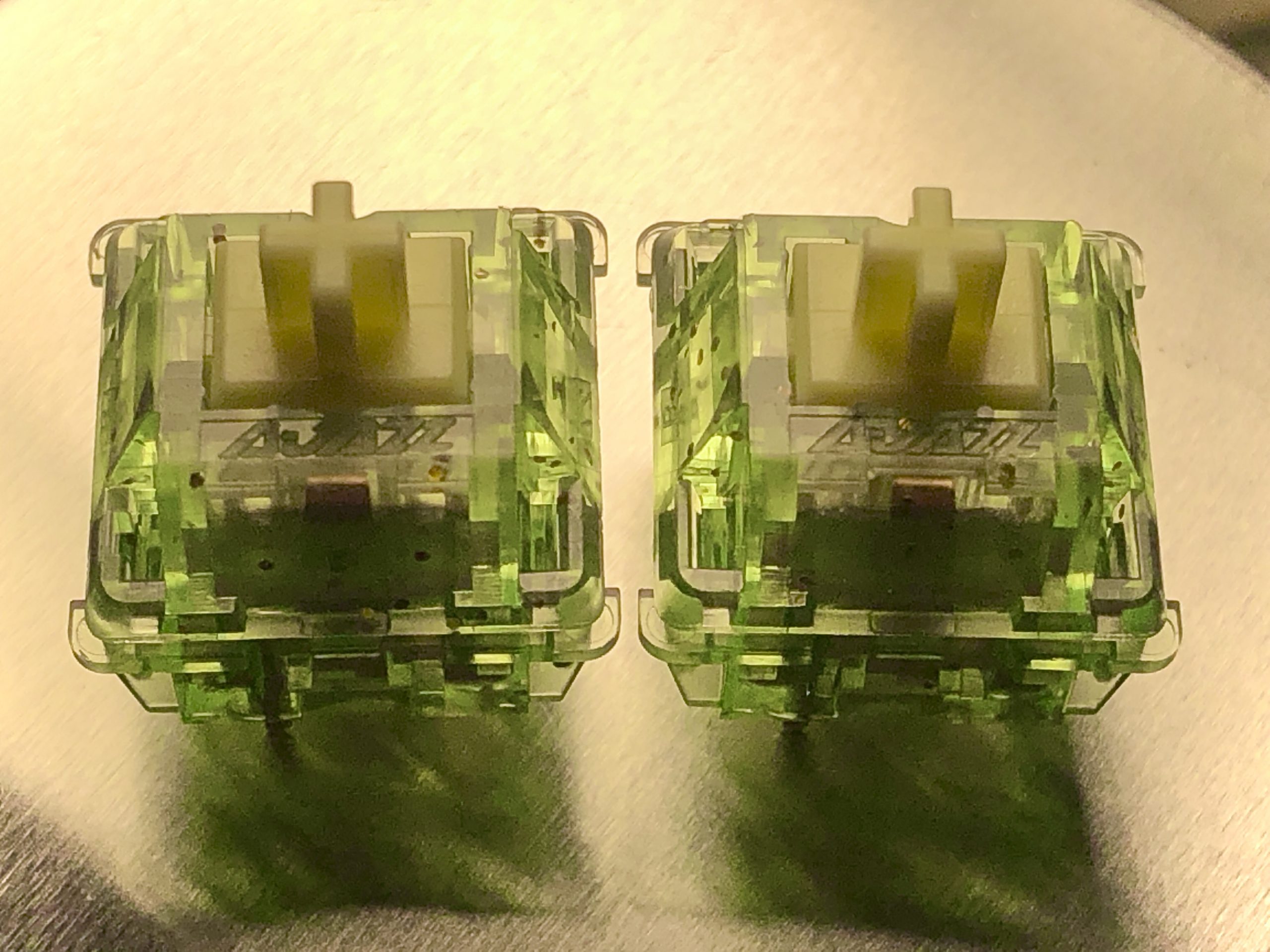
Comparing the two styles of badge I’ve seen on these so far; one where the text looks filled-in, one where it looks outlined; or perhaps one is matte and one is shiny. I’m not sure if it’s an intentional revision or just inconsistency.
Sound:
My chair decided to be very squeaky that day…
These are clackity, snickity-snackity switches – and remarkably clean at that. For the most part, all you’re going to hear with these is the bottom and top-out sounds; not much in the way of scratch, swish, crunch, ping, ring, or any of that other stuff one might expect from a factory tactile with a steep bump.
The top-out is a little thin with just the tiniest hint of dry impact rattle; but this is really reaching for nit-picks. While they have excellent performance in their own right, their extra-short travel inherently makes stabilizer tuning more challenging, which I think is worth consideration. All that said, I give these a subjective sound score of A-. That is, exceptionally clean from the box for a steep tactile; complicated by a slight mismatch with standard stabilizer specs.
Feel
I think this is really where the DF Kiwis stand apart; the combination of super-short travel with a smooth top-bump and a pre-loaded spring makes for a pretty novel experience.
Probably the first thing to mention about the overall feel of these switches is just how snappy they are, along with the short travel, of course. The go down with a snap, and pop back up affirmatively. The have a sprightly cadence that reminds me of running down a hill just a bit too quickly, to the point of nearly tumbling. If you can strike the balance, you’ll be flying indeed. Each crispy clack like the crackle of rocks under the feet of a fell runner.

Kinda like this. • Photo from suunto.com
Once cresting what I feel is a steep but short learning-curve, I found these easy and intuitive to use quickly and accurately. They were quite strange to me at first, but after just a day or two I felt right at home with them.
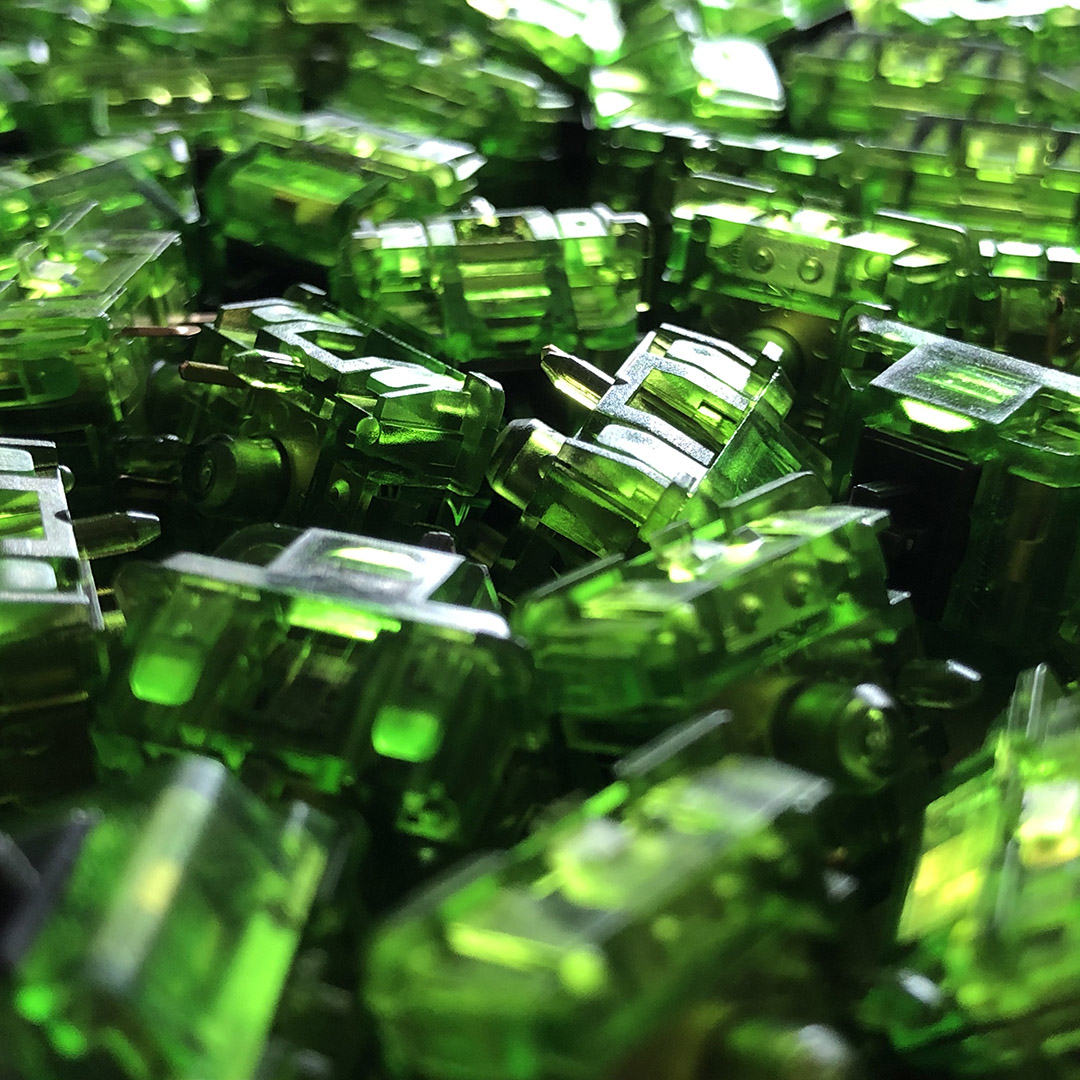
A sea of Kiwis – the TKC ones, that is.
Before I get too deep into the individual details here, I’d like to make a direct comparison to the TKC Kiwi. Compared to that switch, the DF Kiwi:
- Is much shorter travel, by about 0.7mm
- Has a shorter, lighter bump
- Has a lighter bottom-out weight
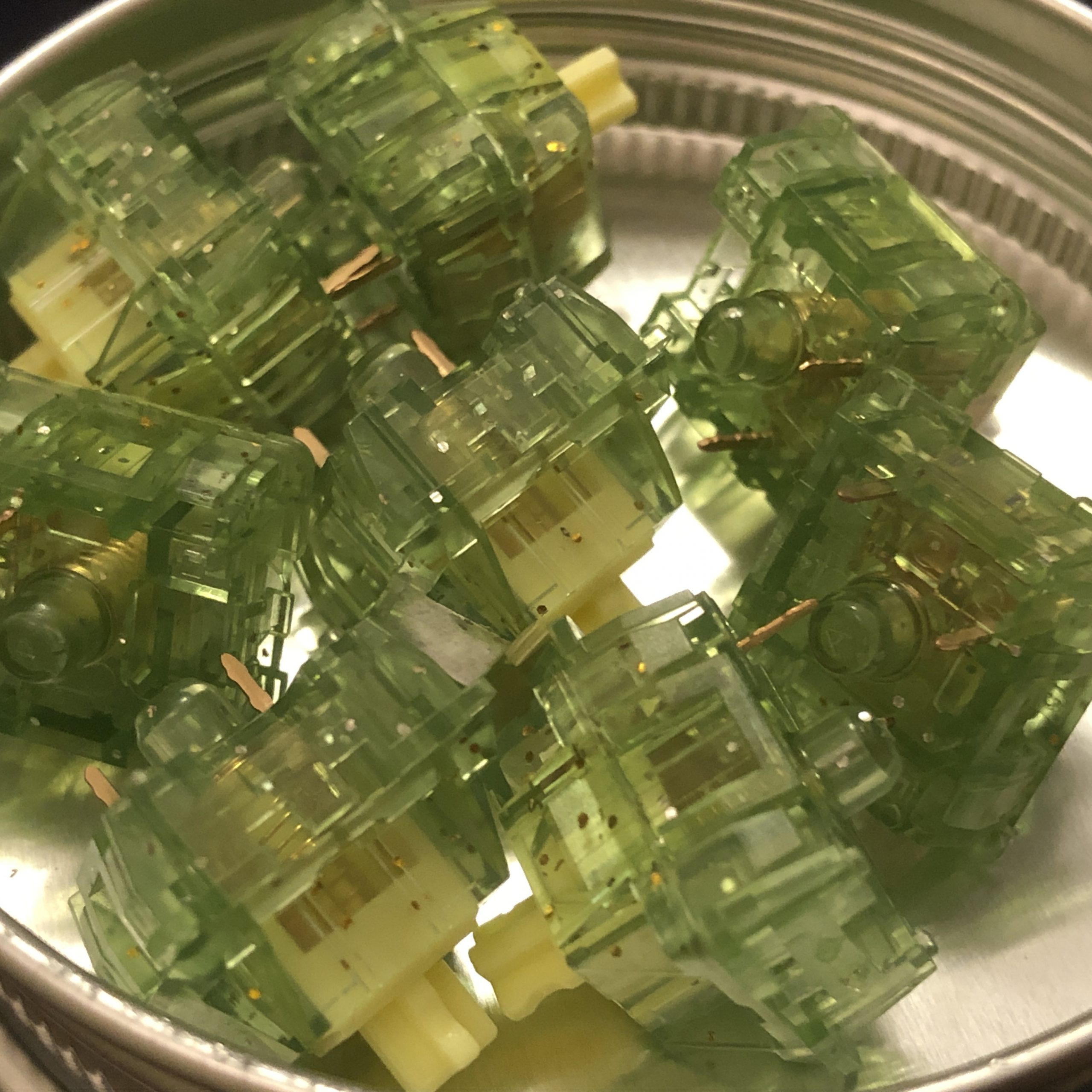
A cozy bunch of DF Kiwis
Let’s get into the details…
Feel – Smoothness:
There’s only so much I can say about the smoothness of a switch whose tactile bump consumes most of its travel – but is it smooth? Yes. Yes it is.
In normal typing, there’s no grit or grain to speak of – nor is there any scratch or even texture, for that matter. You get the bump, you get the clack, you get the top-out. The journey between is a short interplay between the spring and leaf, none of which generates any unwanted friction.
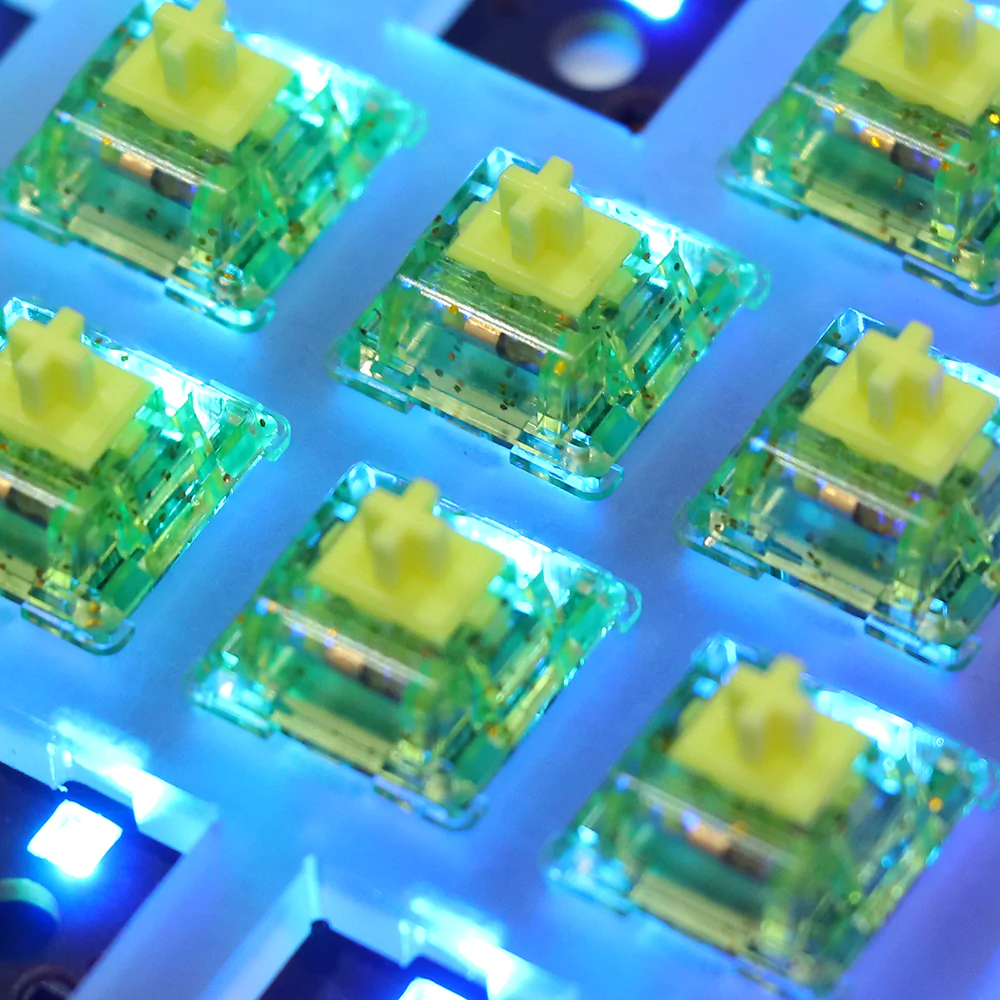
A photo from the Ajazz sales page for these switches
Holding the switch up to my ear and actuating it very slowly like some kind of obsessive crazy person, I still don’t feel or hear any scratch. Even though it doesn’t need smoothness to be an enjoyable snappy tactile, it’s plenty smooth anyway. I think the only thing detracting from this (as well as the sound) is a dry quality to the top-out.
All this in mind, DF Kiwis earn a solid A- from me when it comes to being a slick tactile.
Feel – Stability:
Resting position wobble /10: N/S – 2, very little | E/W – 2, very little
Bottom position wobble /10: N/S – 3, quite low for a long-pole | E/W – 2, very little
Travel Stability: 8/10, Very Good
Housing Fitment: 9/10, Excellent: A
Cap Fitment: No apparent issues: A
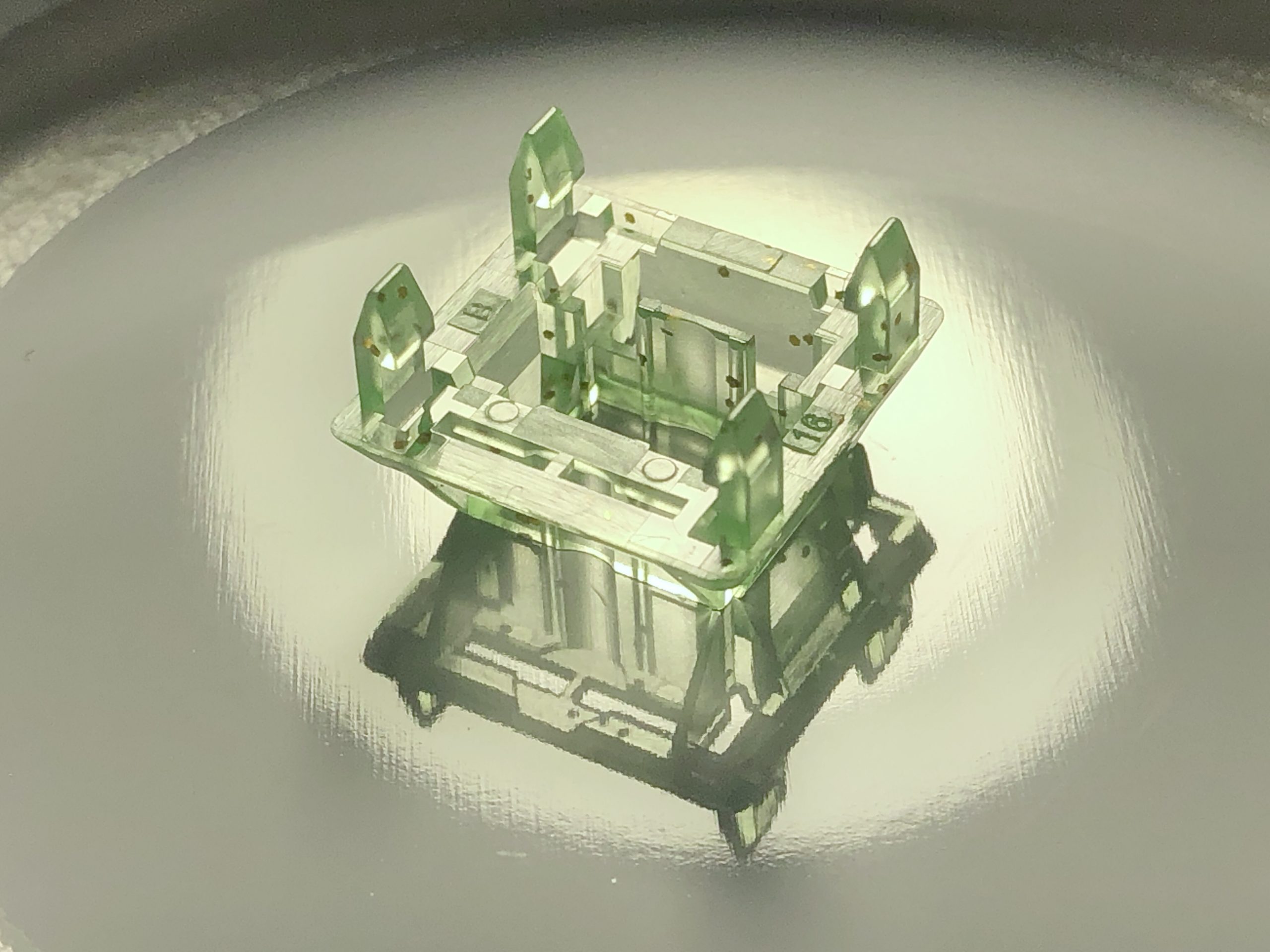
Here’s the underside of the top housing, because I wasn’t sure where else to put it. Note the lack of leaf-teeth, like Outemu and TTC.
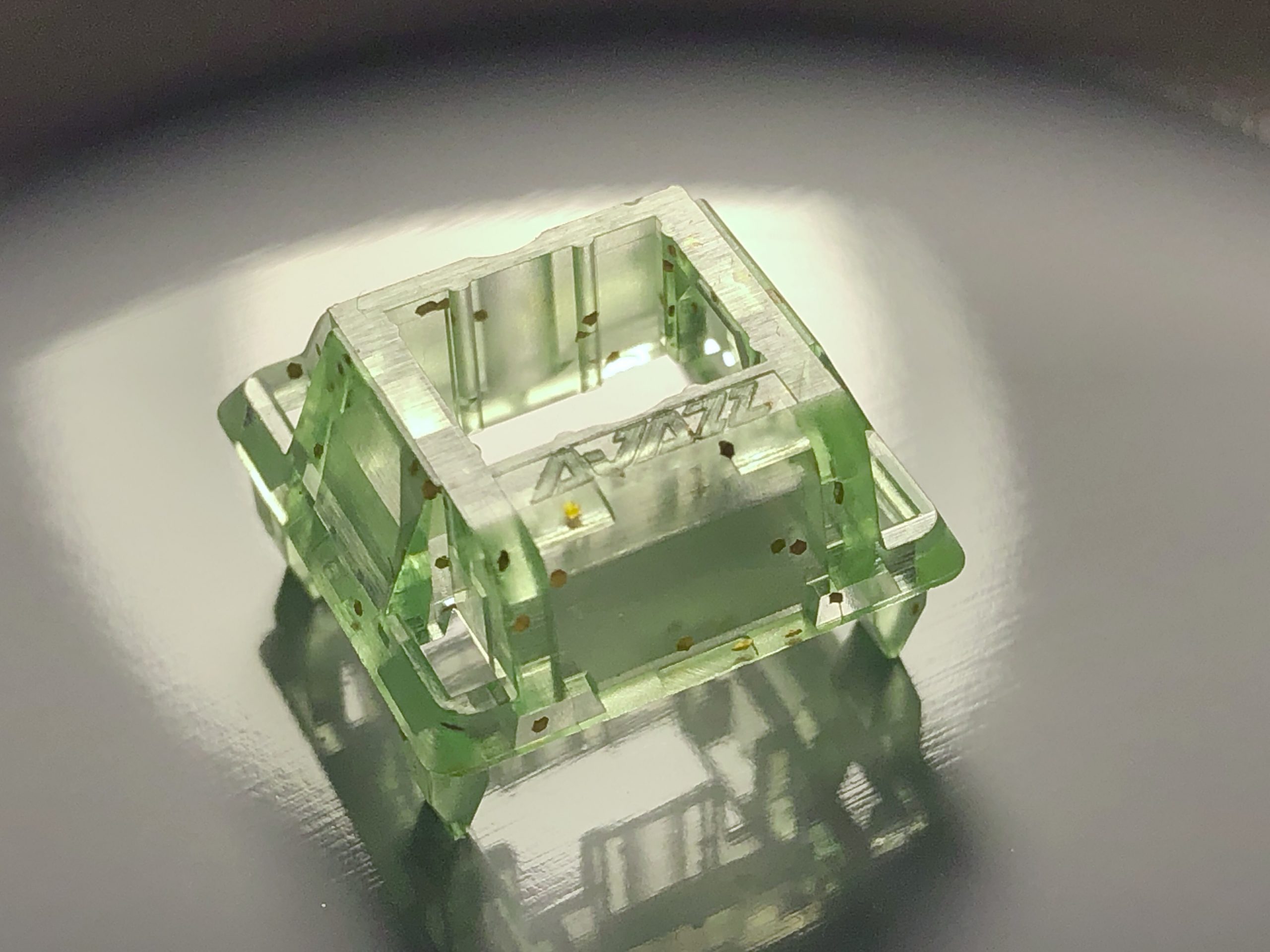
Here’s the top-side, if you were curious
Overall, DF Kiwis have less wobble than average, seemingly aided by the spring. You can make this switch wobble a bit, but it’s not really inclined to in normal typing. Said another way, the travel stability carries-over to aid both the resting and bottom position stability, and in normal use the switch feels very stable – exceptionally so for a long-pole variety. I’d give these an easy A for overall stability.
Feel – Weighting:
TL;DR: The bump is super-steep, right at the top, and matches the bottom-out weight. While it looks kind of extreme on paper and does feel very index-y, it’s surprisingly approachable, even light-feeling once you orient to the shorter travel.
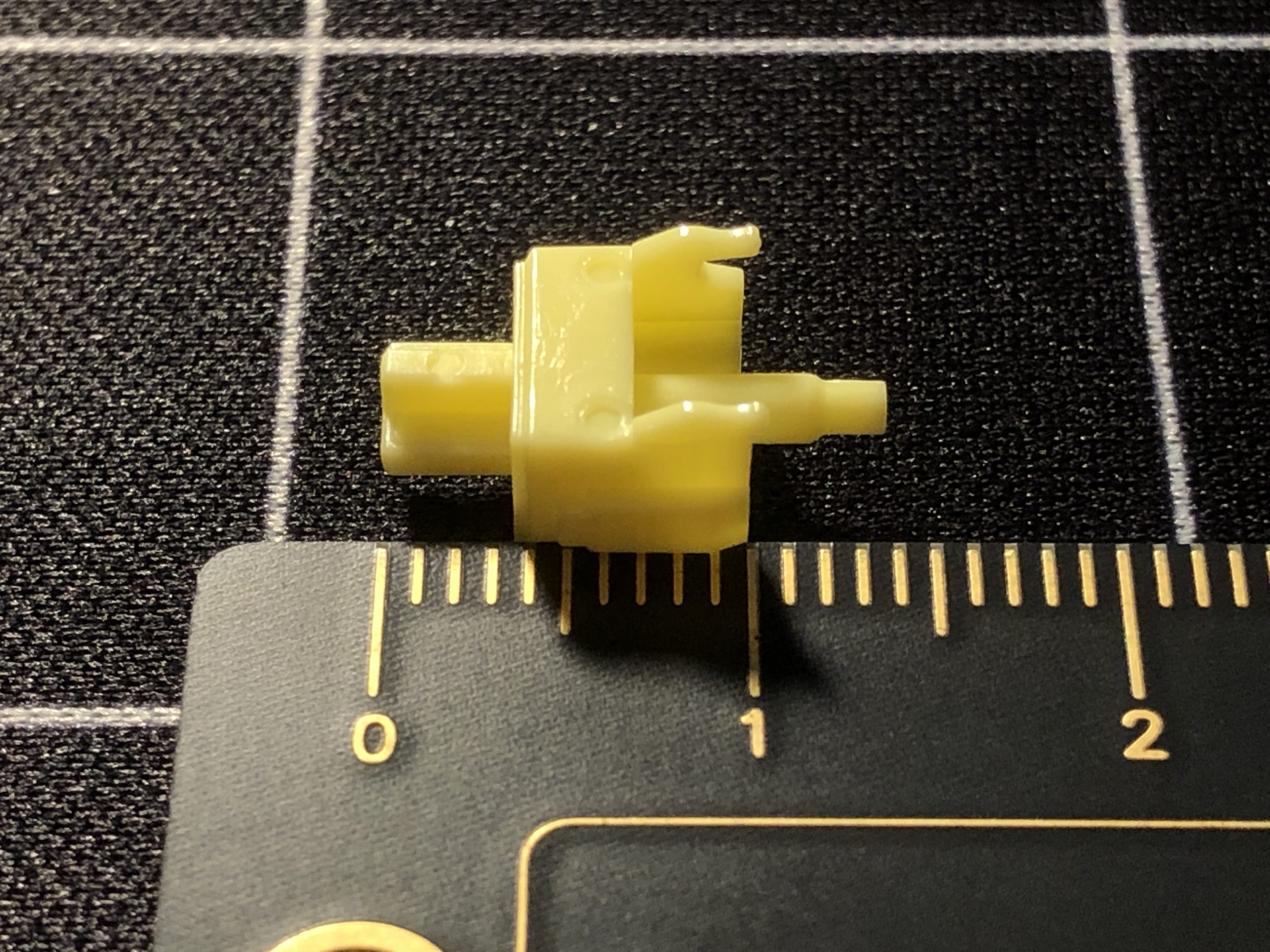
The stem, looks like around 13.75mm
The stronger the tactile bump, the more of a role it plays alongside the spring in how the weighting feels. The spring here has an approachable weight with plenty of preload, making for a small delta between the start of movement and bottom-out. Add to that a snappy-yet-smooth bump all the way up-top, and you get a remarkably well-balanced feel for such short travel.
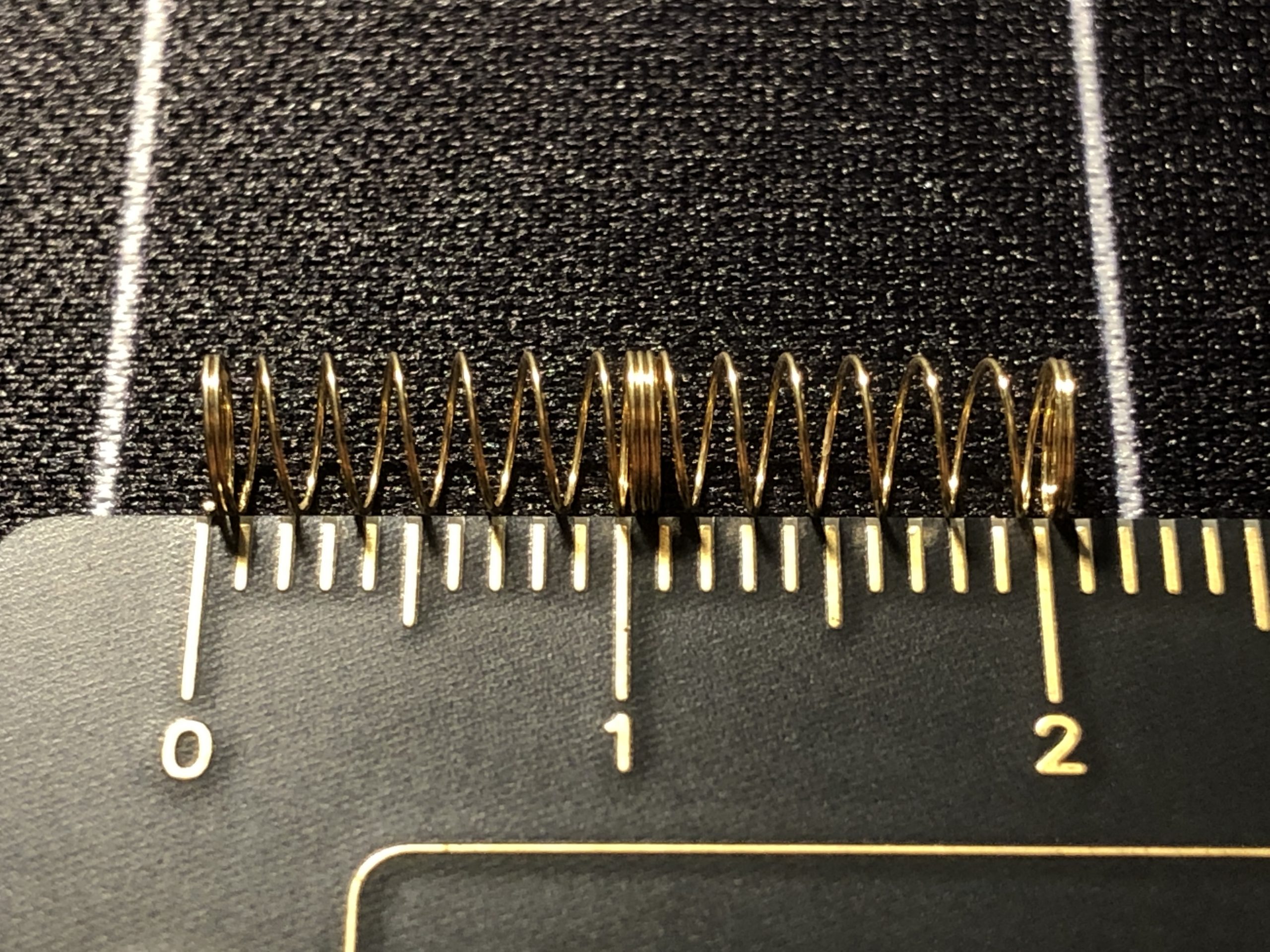
The ~21mm two-stage spring
According to the illustrated factory force-curve graph, the tactile event of this switch takes up 2/3 of the entire travel – which at typing speed, feels like the entire travel. While the bump is very snappy and does confidently resist all but the heaviest of fingers from accidental actuation, it also isn’t nearly so heavy-feeling as it looks on that graph, and I think there’s a good reason for that.
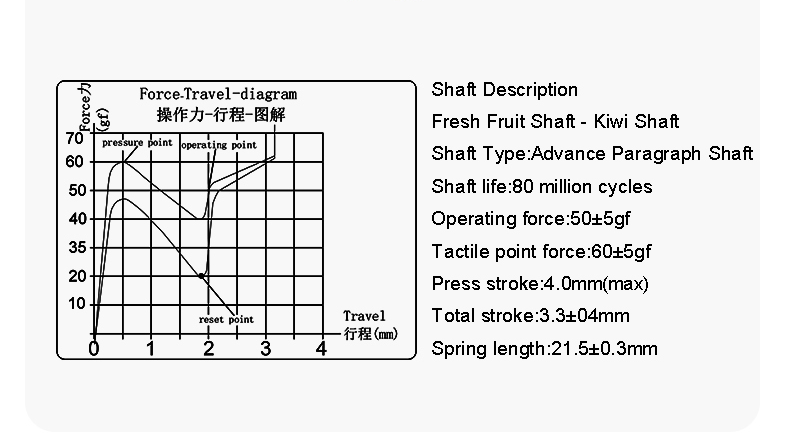
Factory spec sheet snippet with illustrated force-curve graph
The peak of the tactile bump lines-up nicely with the peak force of the spring at bottom-out. Once you’ve applied enough force to start the switch moving at all, you’ve applied enough force to push it all the way down – this is why it’s challenging to type on these without striking bottom. This is an on-off indexing type of switch, which happen to be one of my favorite tactile sub-types.
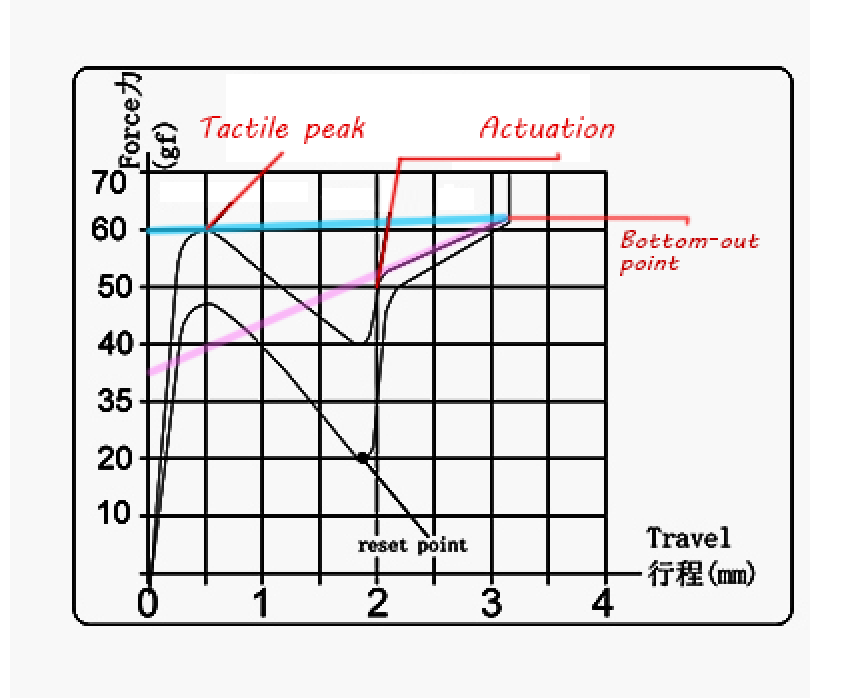
An annotated version of the factory graph to illustrate some of the relationships I mentioned
All of that established, I think we’re beginning to have a clear picture of the things that make this switch what it is, and why it feels the way it does. In a “traditional” MX tactile, the tactile event is a bump around the middle of the force-curve otherwise dominated by the spring. In switches like this, the force-curve is dominated by the tactile event, itself an interplay between the bump and spring taking up most of the travel.
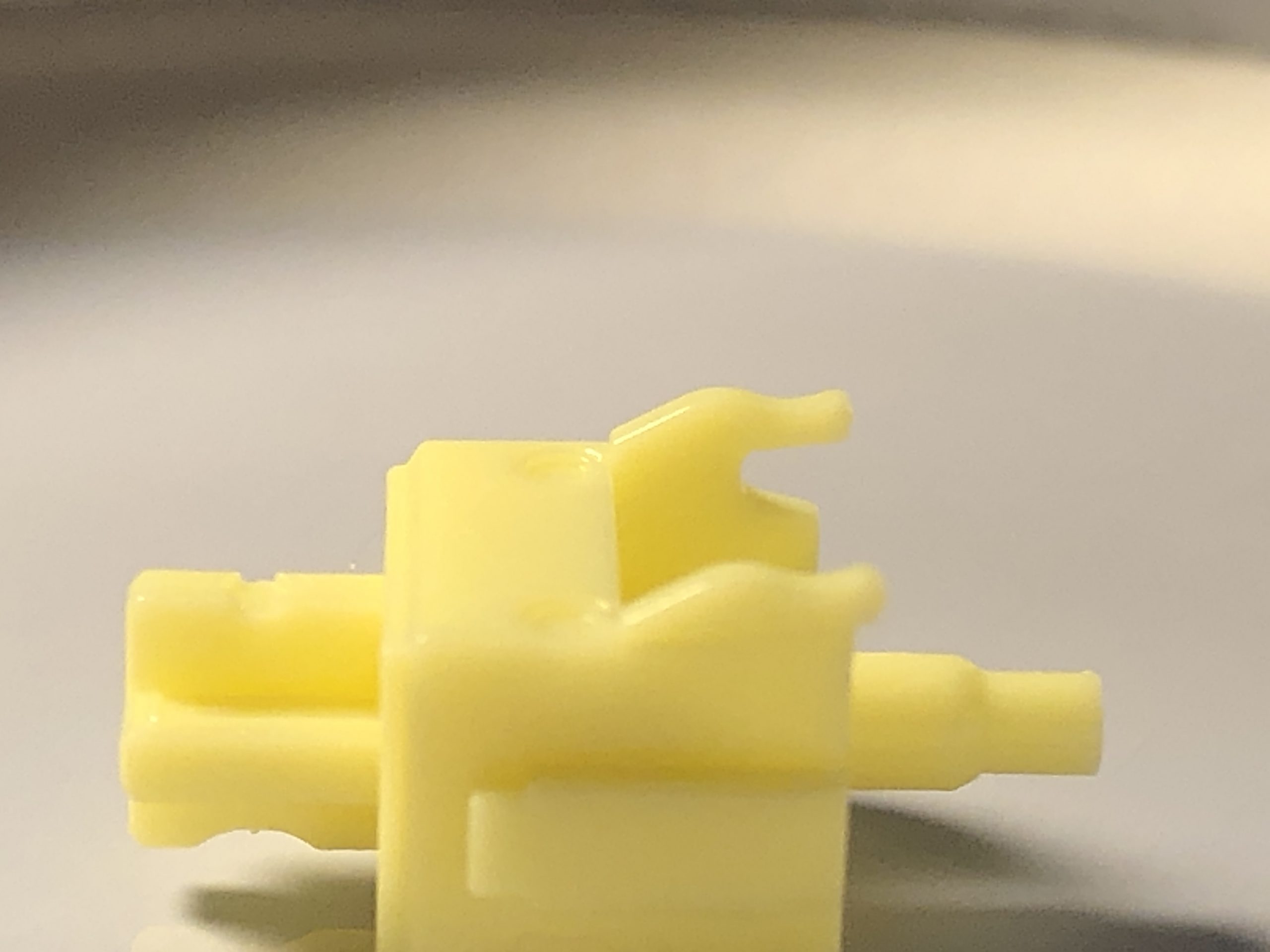
A close-up of the stem and it’s snappy bump
I may be biased with my preferences here, but I think this switch strikes an excellent balance of weight between its spring and bump while keeping the peak force in very reasonable territory, making for a very tasty tactile experience. That in mind, I give these a subjective A+ for weighting.
Reliability & Caveats:
This is a section where I talk about functional reliability, and consolidate any other caveats that may have come up in any other sections into a list of suggestions for potential improvement.
Consistency: In this kind of switch – that is one dominated by its tactile event – I think it’s always a bit more difficult to pick-out consistency issues with feel or even sound. Whether or not this counts as an advantage of the style I’ll leave to you. All this said, I haven’t run into any functional consistency issues at all with these since I started using them, and they all sound and feel pretty much the same to me. However – I will note at least two permutations of the name plate badge, as I mentioned in the Aesthetics section above.
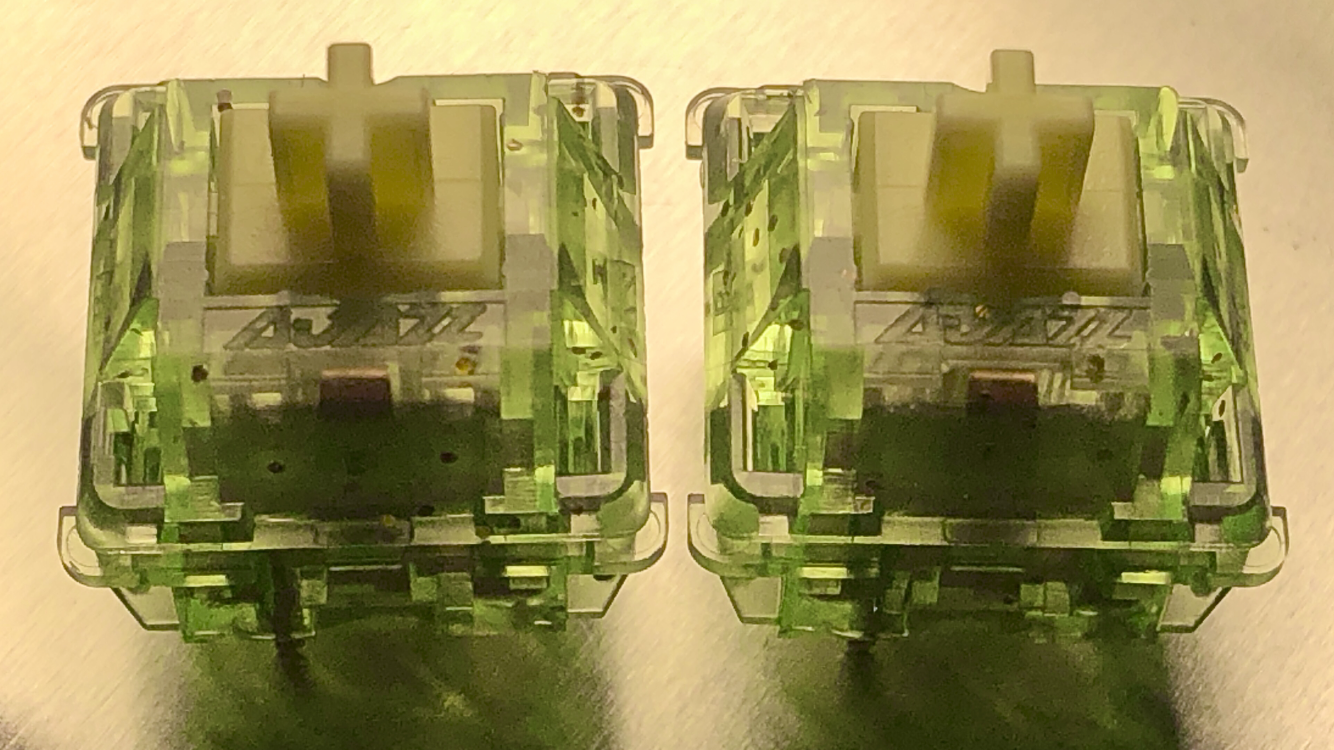
Another look at the inconsistent name plates; pardon the annihilated white-balance
Functional Reliability: Huano claims a life of 80-million actuations. I’m obviously not in a position to verify that, but I can tell you that I haven’t experienced any issues with these when it comes to functionality: no chatter (double inputs), dead switches, or otherwise weird behavior.
When it comes to overall reliability I’ll give these a clean A+ for the specified long life and apparent lack of consistency issues.
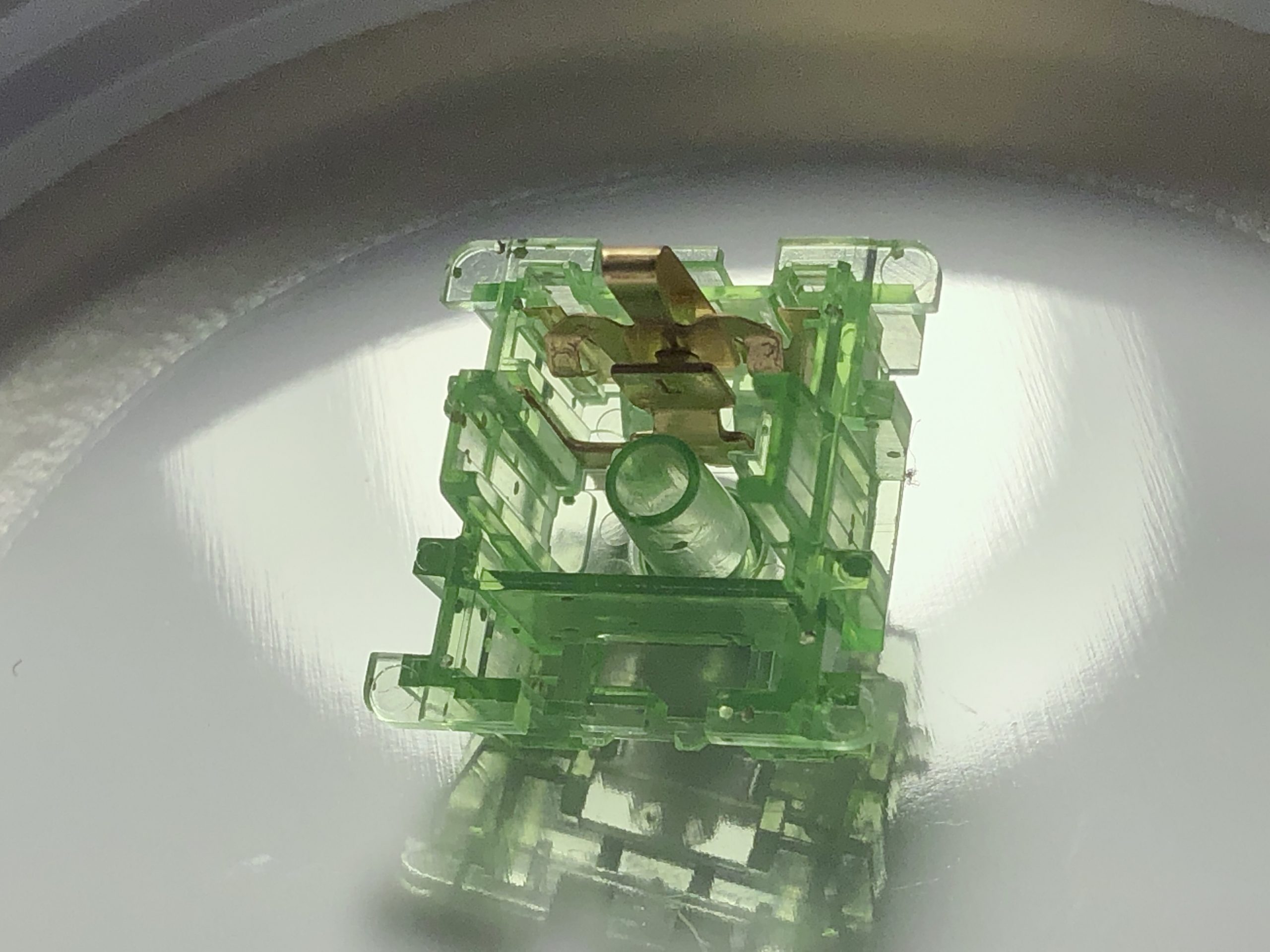
A look at the bottom housing, with what looks like light grease in the center tube and on the contact rails.
Other Caveats: Aside from just getting used to them, another important consideration with any long-pole or otherwise short-travel MX-compatible switches is how that travel relates to the stabilizers. These days some manufacturers are making *long-pole stabilizers with longer mounting stems, but those are a set additional length, and the switch travel comes in many varieties. There’s still potential for issues caused by the discrepancy between switches and stabs, mostly in the form of tick and teeter. This in mind, I give these an admirable B when it comes to compromise.
My favored way to deal with these problems is still OKLB’s North-facing compatibility washers – thanks again to walkerstop for this fantastic advice that I use constantly. If only the washers weren’t so hard to come by!
Another option is to use thick and/or stacked pads from stabilizer tuning kits like the C3 Equalz Soulmate, or even just random bits of adhesive-backed foam.
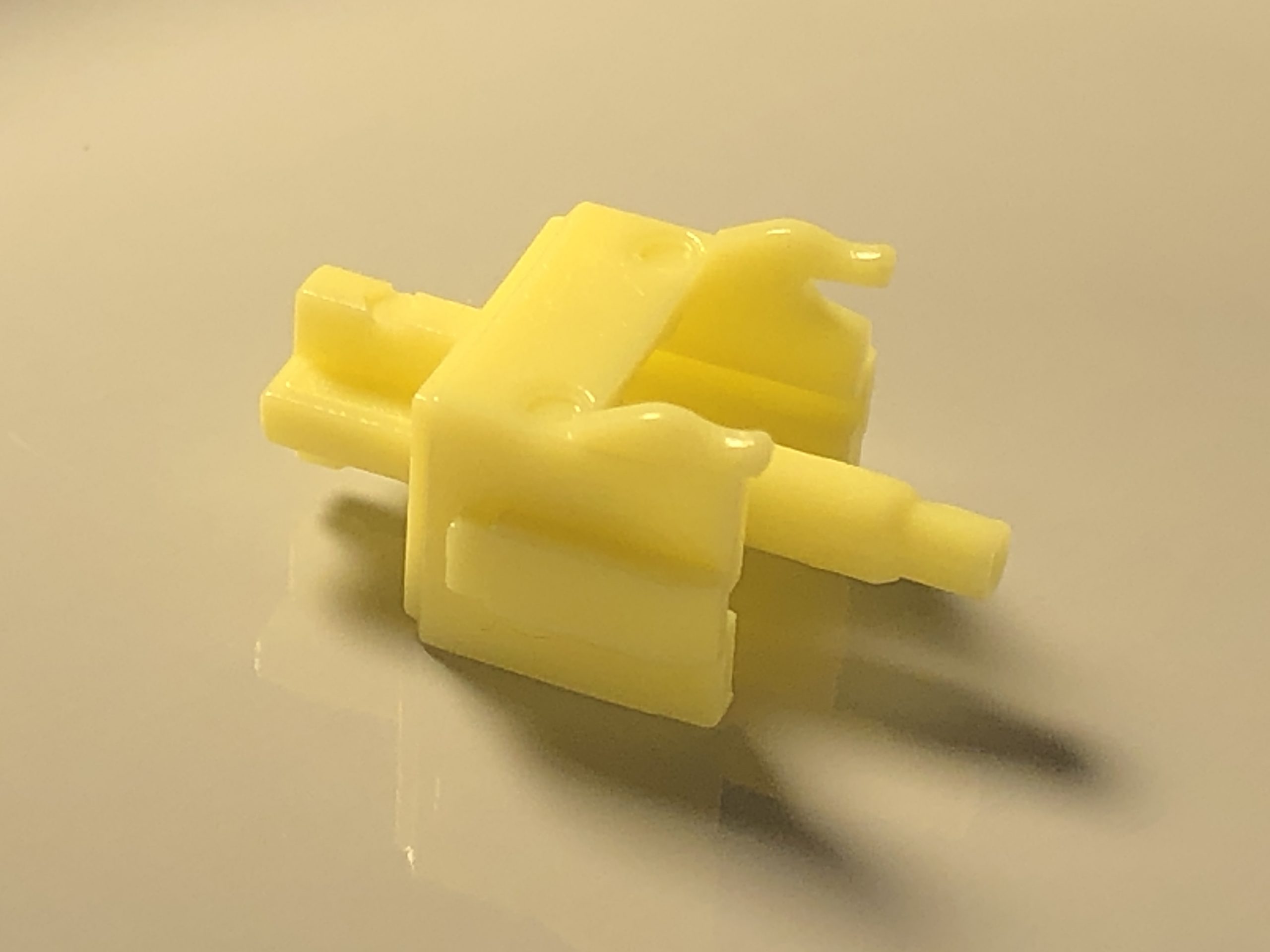
Another close-up of the stem, complete with extra-long pole and little ejection marks that make the front look like a cute surprised spider face
Suggestions for improvement: I don’t think these switches really need anything, but walled stems with further improved tolerances might be worth considering whenever it’s time to refresh the tooling.
Value:
At around 45 cents each, these are a middle-priced switch – and aside from being a fairly interesting sub-type, I think their stock quality outshines most peers in the bracket. The DF Kiwis earn a solid A for value in my book.

It looks to be pretty standard for the Diced Fruit switches to come 45+1; mine did. 45 sealed under a fruit-can style pull-tab top, and one open in the box – in case you want to try one and don’t feel like breaking the seal just yet.
Recap & Conclusion:
Aesthetics: A+
Sound: A-
Smoothness: A-
Overall Stability: A
Housing Fitment: A
Cap Fitment: A
Spring Feel: A+
Reliability: A+
Compromise: B
Value: A
Overall subjective score: A-
I’d been sleeping on these for years, figuring them to be knock-offs of the other switches named after the same fruit. I picked some up on a whim, and they surprised me twice: once by being nothing like the other Kiwis, and again by being consistent, clean, and generally excellent right from the box.
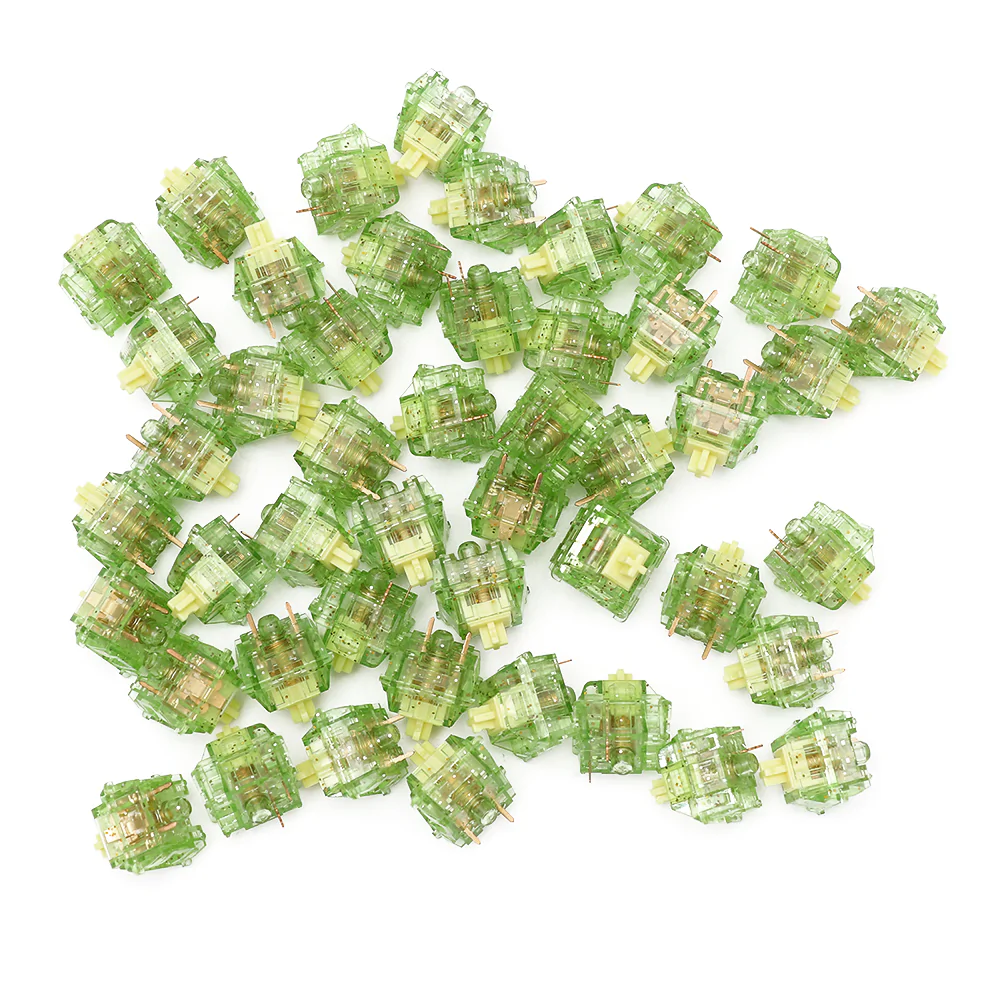
Another product photo; a collection of DF Kiwis
They threw me off with their short travel in the beginning, but their crystal-clear haptics and well-balanced tactility make them fast, natural typing switches for me. DF Kiwis are some of my new favorite tactiles.
Alright – that’s all I have to say about the Ajazz × Huano Diced Fruit Kiwi switches for today. Thanks so much for reading, and have a good one!

